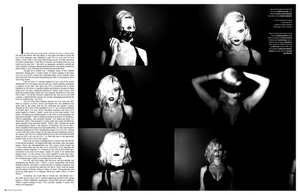Context
Alexandra Valenti is a mixed media artist who blends patterns made in watercolors with photography from Austin, Texas. Her art has been described as a "dreamy, sun-drenched flashback that jolts you from your current moment in time and into a psychedelic world all its own". She has designed for magazine spreads, CD covers and even advertisements. Even though a lot of her work is for profit she initially started creating pieces through her mere passion for the art. These pieces were all created in the 2012, and in some ways they do reflect this. The clothing of the model's is all very in-keeping with with the ,now-popular, vintage style. This adds another layer to the appeal of Valenti's work as the mis-en scene created fits in with the current trends of today.
Form
The colour palette for Valenti’s work is achromatically based. However, on the particular set that I've been looking at there’s an insert of bright,eye-catching colour which juxtaposes with the monochrome background. The tone of the actual photograph varies quite a lot due to the different light sources and exposure, but this is manipulated to add another layer to the finished print. While the splash of colour initially looks bright, the colours on the photograph above actually have quite a low saturation.
This image is a combination of hand-drawn and digital art, and the addition of the painted circle gives the picture a more abstract feel. The hand-drawn element reduces the rigid structure of the photograph, and there is evidence of the ‘hand that made it’ in the color work itself. You can see the brushstrokes in some parts of the colour which adds more detail to the finished piece.
Also, the overall finish of the prints seems to have a very light grain over them to make them appear more vintage and aged.
The whole ambiance and mis-en-scene created within the image is quite rustic. The recurring nature theme gives an earthy feel, the one above even includes water which only emphasises this further. The choice of clothing and hair/makeup within photography is also crucial. In this photograph the girls hair is loose and seems very natural (it’s not been perfectly styled, just left to it’s own devices) intensifying the initial feeling of freedom. The fact that the model looks to be naked in this picture also highlights this. The lack of identity here could suggest that it could be anyone stood by the river, even you. Unlike a lot of staged, set, photography the audience feels less alienated in this kind of situation because it’s a lot more relaxed; the absence of perfect lighting and a flawless face/figure/hair is far less intimidating.
Processes
Interviewer: What’s inside your camera bag?
Valenti: A Leica, a Nikon, a point and shoot… lots of batteries
Interviewer: Your photo’s have a signature feel. Does the vintage look come from using film or Photoshop?
Valenti: Both. I treat my photographs whether it’s film or digital. It’s part of the fun for me.
For this image Valenti would have taken the initial photograph, most likely in standard colour settings as opposed to sepia. She wouldn't have needed to set up any lighting because of the outdoor setting, however she will have had to have taken the suns positioning into account as this would change the tones within the image. Once she had the photograph it was probably altered in photoshop to create the sepia palette and some noise or texture was probably added to emphasis the vintage style.
The colour circle will have been first drawn out in pencil then watercolor. The detailed part in the center will have been either done using some sort of fine liner or black ink. The circle will then have been photoshopped onto the photograph and the colour may have been adjusted slightly. Valenti would have had to cut around the figure of the girl in this case to successfully put the circle in the background and bring the model to the foreground.
Personal response
The first thing that drew my attention about Alexandra Valenti’s photography was the sporadic use of colour she uses on such a sepia, vintage style photography. Her main subject matter of nature, summer and water makes her photographs feel almost dreamlike. It reminds me of festivals and summer holidays which evokes pleasant and adventurous feelings. I find the ‘freedom’ element really inspiring and just the model having her arms raised in such a fashion gives a sense of possibility and opportunity. I also like how the photographs are actually quite simple and not in staged rooms and so in some ways ‘false’. The addition of the watercolour adds an intriguing layer to the image without trying to be over-zealous or extravagant.













